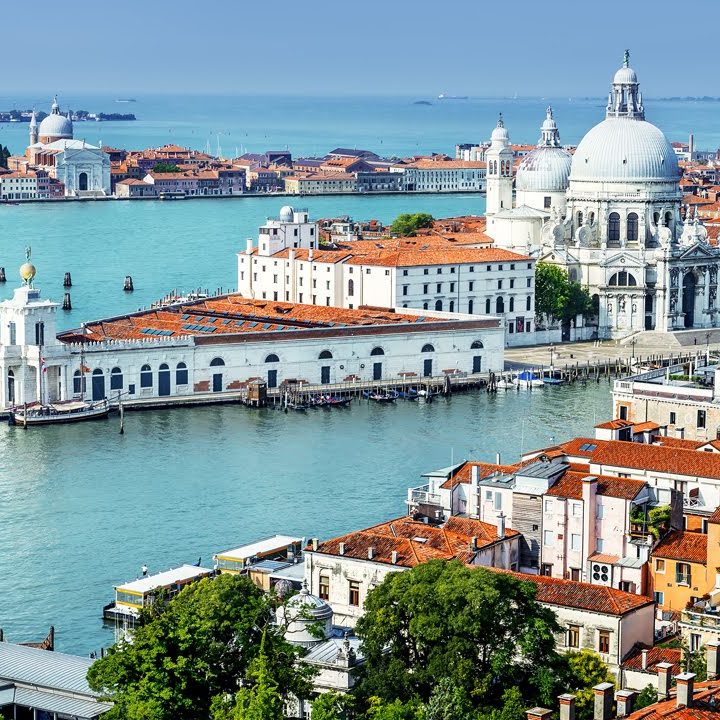ITALY – Venice
Wonderful, sunny, wealthy, lively yet quiet and intimate: this is how the cities of art in the Veneto region are seen in a traveler’s eyes, seducing and winning over lovers of art, history and architecture.
Venice is the most splendid, a fantastic open-air museum with its endless treasures and priceless beauty, symbolized by Piazza San Marco, “the most beautiful sitting room in the world”.
Piazza San Marco is the only “Square” in Venice, as all the other square are given the name “Campo”. From the very beginning, Piazza San Marco was designed and built as an extension of Palazzo Ducale and the San Marco Basilica, the true centers of political and social life in Venice. The space originally taken up by the square was rather narrow and had a canal running through it: the Rio Batario. In 1172, the Doge Sebastiano Ziani bought the whole area and reclaimed the canal. He then had extension work started which ended in the Piazza San Marco that we now know today.
Opposite the Palazzo Ducale, and in place of the old wharf, a small square was created where two tall columns coming from Constantinople were installed. A winged lion was placed on one column, which is the symbol of Venice, and on the other column there was a statue of San Teodoro, the old patron saint of Venice, who was then replaced by San Marco.
The larger part of the square that stretches out in front of the Basilica, is 170 meters long and is trapezium shaped.
The edge of the square is bordered by the old and new Procuratie, and the Napoleonic Wing which is now the home of the Correr Museum.
The Bridge of Sighs is one of the most popular tourist sights in Venice. The bridge connects the Palazzo Ducale, where prisoners were tried, to the prisons known as the Piombi. The bridge was built on the orders of the Doge Mario Grimani and was made in stone from Istria. It was decorated on the outside with Baroque patterns. The beauty of the structure has given the bridge a romantic connotation in complete contrast to its actual use. The sighs that the bridge inspired were definitely not sighs from people in love, but from the prisoners who had just been sentenced to years in jail in the terrible “piombi”. The Mercerie cut the old city center into two parts, connecting Piazza San Marco to Rialto.
This is Venice’s main throughway, the heart of the city’s commercial trade since ancient times when the precious fabric shops stayed open until late. The Mercerie are divided into three parts: Mercerie dell’oroloio (that starts from Piazza San Marco), Mercerie de San Zulian and Mercerie di San Salvador, that come out right on Campo San Salvador, next to Campo San Bortolo. All the Mercerie are full of shops and boutiques of all kinds: from luxury jewelers such as Cartier and Rolex to fashion boutiques such as Sergio Rossi for shoes and Krizia for clothes.
The famous Rialto Market has two parts to it: Erbaria and Pescaria. Erbaria is the fruit and vegetable market which is right under the Rialto Bridge, on the opposite side to Campo San Bortolo. Pescaria is the fish market and is just a short walk away, under the porticoes of a neo-Gothic building that looks out on the Grand Canal. If you have an extra day to hand, why don’t you visit the lagoon islands? Murano, Burano and Torcello. The island of Murano became famous in 1291, the year in which the glass production was transferred here from the old city center due to fear of fires in the kilns.
You will catch a glimpse of the San Michele island while traveling between le Fondamenta Nuove and Murano. This is Venice’s cemetery where famous people such as Stravinsky and Diaghilev are buried.
Once you get to Muran, walk along the Fondamenta dei Vetrai, where you can see the famous kilns lined up one after the other. Some of these are open to the public: choose one to watch the expert master glass blowers creating an object in glass. You can also buy blown glass things at the kilns directly. One of the oldest glassworks is Venini, a company that exhibits its own work in many Museums of Modern Art around the world. Just before the Vivarini Bridge you will see the Church of San Pietro Martire on your left, where there are some frescoes by Bellini, Tintoretto and del Veronese. Burano is one of the prettiest islands in the lagoon: it is a miniature Venice where all the houses are painted in bright colors. Burano is famous for its lace work, an art carried out since the sixteenth century and which is famous worldwide.
Walk along Via Marcello and then turn right to the Fondamenta di San Mauro: You will soon come to Via Baldassare Galuppi that opens onto the square with the same name. It is possible to reach the island of Torcello from the Fondamenta Nuove. Torcello is an extremely romantic and charming place. Venetians love to go there once in a while as they are attracted by its calm and the greenness of the island. Unlike Murano and Burano, Torcello is practically uninhabited and still has a lot of archeological proof of its glorious past.
From the wharf, walk along the pleasant Fondamenta dei Borgognoni where you will immediately see the famous Ponte del Diavolo (the Devil’s Bridge). Further on there is Piazza Torcello, with its original grass flooring where you can see the wonderful, ancient Cathedral of Santa Maria Assunta.


